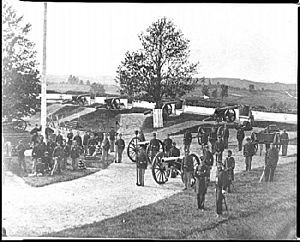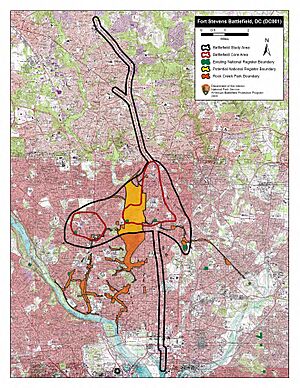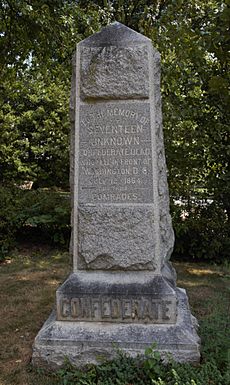Battle of Fort Stevens facts for kids
Quick facts for kids Battle of Fort Stevens |
|||||||
|---|---|---|---|---|---|---|---|
| Part of the American Civil War | |||||||
 Officers and men of Company F, 3rd Massachusetts Heavy Artillery, in Fort Stevens |
|||||||
|
|||||||
| Belligerents | |||||||
| Commanders and leaders | |||||||
| Alexander M. McCook Horatio G. Wright Abraham Lincoln (observer) |
Jubal Early | ||||||
| Strength | |||||||
| 9,600 | 10,000 | ||||||
| Casualties and losses | |||||||
| 373 | 400–500 | ||||||
The Battle of Fort Stevens was an important fight during the American Civil War. It happened on July 11 and 12, 1864, in what is now Northwest Washington, D.C.. Confederate forces, led by Jubal Early, tried to attack the capital city. However, Union soldiers, helped by strong defenses at Fort Stevens, stopped them.
A famous part of this battle is that Abraham Lincoln, the US President, watched some of the fighting. The Confederates eventually left without launching a major attack. This battle showed that Washington D.C. was well-defended.
Contents
Why the Battle Happened
In June 1864, Confederate General Robert E. Lee sent Lieutenant General Jubal Early on a special mission. Early's job was to clear Union forces from the Shenandoah Valley. He was also ordered to invade Maryland and threaten Washington, D.C..
The Confederates hoped this attack would force Union General Ulysses S. Grant to send troops away from Richmond, Virginia. Richmond was the Confederate capital, and Grant was trying to capture it. By threatening Washington, Lee hoped to weaken Grant's army.
After some fighting, Early's army marched north. They entered Maryland on July 5 and reached Frederick by July 7. On July 9, Early's troops fought a smaller Union force at the Battle of Monocacy.
The Union soldiers at Monocacy were mostly local troops. They fought bravely but were eventually defeated. However, this battle bought valuable time for Washington D.C. Early's army was delayed for a whole day.
After the battle, Early continued his march. His soldiers were very tired from the long march and the hot summer weather. They also stopped to loot a house near Silver Spring. Because of these delays, Early decided not to attack Washington until the next day.
Meanwhile, Grant had already sent more Union troops to Washington. These were experienced soldiers from the VI Corps and XIX Corps. They arrived in Washington on July 11, just as Early's troops were reaching the city's defenses.
Washington's Strong Defenses
Washington D.C. was getting ready for the Confederate attack during a very hot summer. Many people, including members of Congress, left the city to escape the heat and the danger. But President Lincoln stayed close by.
The city had many forts, batteries, and trenches. There were 87 forts north of the Potomac River, facing Early's army. These forts had many heavy guns and thousands of soldiers. The land around the city was cleared to give defenders a clear view of any attacking forces.
However, many of the soldiers defending Washington were new recruits or recovering from injuries. They were not all ready for battle. Out of 31,000 troops, only about 9,600 were truly ready to fight. This meant the Confederate army, with about 10,000 soldiers, was a real threat.
Experienced Union generals were in charge of the city's defenses. When the veteran VI Corps arrived, it brought much-needed reinforcements. These experienced soldiers were quickly moved to the front lines to face Early's army.
The Battle Unfolds
When Early's army arrived at Fort Stevens, they delayed their attack. Early was unsure how strong the Union defenses were. Also, many of his soldiers were still arriving and were exhausted.
Around 3 p.m. on July 11, the Confederates began skirmishing. This means they sent out small groups of soldiers to test the Union defenses. Union artillery from the fort fired back, destroying houses that Confederate sharpshooters were using for cover.
As the fighting continued, more Union reinforcements arrived. These were the battle-hardened soldiers from the VI and XIX Corps. Their arrival greatly strengthened the fort's defenses.
The fighting became more intense around 5 p.m. Confederate cavalry pushed forward, but a Union counterattack drove them back. Both sides then faced each other, with periods of heavy skirmishing throughout the evening.
Lincoln at the Fort
President Lincoln, along with his wife Mary and some officers, came to Fort Stevens to watch the battle. This happened on either July 11 or July 12. At one point, Lincoln was briefly under enemy fire. A Union surgeon standing near him on the fort's wall was wounded. An officer quickly told Lincoln to take cover.
More Union soldiers arrived overnight. Skirmishing continued into July 12. Early finally decided that taking Washington would cost too many lives. He realized the attack was not worth such heavy losses.
Union artillery from Fort Stevens tried to clear out Confederate sharpshooters. When that didn't work, a Union brigade from the VI Corps attacked. This attack was successful, but it cost the Union over 300 soldiers.
Aftermath
Early's Confederate forces began to withdraw that evening. They headed back into Montgomery County, Maryland, and crossed the Potomac River into Leesburg, Virginia on July 13. They successfully took with them all the supplies they had gathered during their raid.
After the battle, Early reportedly told one of his officers, "Major, we didn't take Washington but we scared Abe Lincoln like hell." Union forces, led by General Horatio Wright, began to pursue Early's army on the afternoon of July 13.
Battlefield and Cemeteries
Today, Fort Stevens is a preserved site managed by the National Park Service. It is located near 13th Street NW in Washington D.C. This fort is the only part of the battlefield that remains preserved today.
The Battleground National Cemetery was created just two weeks after the battle. It is located nearby and holds the graves of forty Union soldiers who died in the fighting. Seventeen Confederate soldiers are buried at Grace Episcopal Church in Silver Spring, Maryland.




